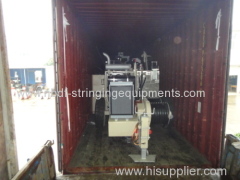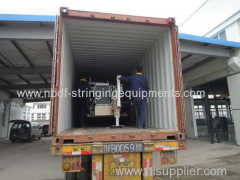





6 Ton Hydraulic Puller Stringing Equipment with Italian Reducer
| Min. Order: | 1 Set/Sets |
|---|---|
| Trade Term: | FOB,CFR,CIF |
| Payment Terms: | L/C, T/T |
| Supply Ability: | 10 sets per month |
| Place of Origin: | Zhejiang |
Company Profile
| Location: | Ningbo, Zhejiang, China (Mainland) |
|---|---|
| Business Type: | Manufacturer |
Product Detail
| Model No.: | SA-YQ60 |
|---|---|
| Means of Transport: | Ocean, Land |
| Brand Name: | Dongfang |
| Cable Winch Puller: | 6 Ton Hydraulic Puller Stringing Equipment |
| Max. pulling force: | 6 Ton 60 KN |
| Max. pulling speed: | 5 km per hour |
| Suitable: | for single or two conductors |
| Diameter of pulling rope: | 18 mm diameter |
| Cummins Engine Power: | 77 KW |
| Dimension: | 3.8 X 2.1 X 2.3 M |
| Weight: | 3000 KG |
| Production Capacity: | 10 sets per month |
| Packing: | container plywood case |
| Delivery Date: | 30-45 days |
Product Description
6 Ton Hydraulic Winch Puller is used for overhead transmission line single or two conductorsstringing. The machine is equipped with Water Cooled Cummins Engine and Rexroth Hydraulic Pump with closed hydraulic control system.
We are the first one in stringing equpment manufacture in China to get CE certificate.

1. SA-YQ60 Hydraulic Cable Puller
Item No. | 07031 |
Model | SA-YQ60 |
Stringing capacity | 1 PILOT WIRE ROPE |
Max. Pulling Force (KN) | 60 |
Continuous Max. Pulling Force (KN) | 50 |
Speed at Max. continuous pull: | 2.5km/h |
Max. Pulling Speed (m/min) | 5km/h |
Root Diameter of Bull wheel (mm) | Φ460 |
Number of grooves | 7 |
Max. Steel rope Diameter (mm) | Φ18 |
Model of Diesel Engine | Water cooled diesel engine |
Power of Diesel Engine | 77 KW |
Rotate Speed of Engine (rpm) | 2800 |
Electrical System | DC24V |
Weight (kg) | 3000 |
Dimension (m) | 3.8 x 2.1 x 2.3 |
Application: The hydraulic puller is used to pull pilot wire rope for overhead transmission line Stringing. It is equipped with diesel engine and closed hydraulic system, it can be easily used and maintained
Features:
-With closed hydraulic circuit and variable displacement plunger pump, the pulling force could be step less controlled, and can be read on the line pull gauge.
-The max pulling force for stringing operation can be preset.
-Automatic over pulling protection system
-With the radiator imported from Germany, the machine has good heat dissipate performance.
-With a negative spring applied hydraulic released brake, and automatic overload protection.
-With hydraulic oil cooling system.
-Heat treated wear-proof steel bull wheels
-With rigid axle for towing at high speed, the machine looks beautiful.
-Integral self-loading reel winder with automatic level wind.
-Heavy duty R-tires with excellent shock-absorbing performance.

Main Components:
-Engine: Cummins water-cooled diesel engine (China)
-Main variable displacement hydraulic pump and main motor: Rexroth (Germany)
-Reducer: R.R. (Italian)
- Main hydraulic valve: Rexroth (BOSCH)
-Hydraulic instruments: WIKA (German)
-Radiator: AKG (German)
- The hydraulic reel winder is equipped with 1400mm diameter steel drum (GSP1400)
The 6 Ton puller can be used in mountain area to pull single or two conductors.

We have designed and produced whole series of hydraulic winch puller for overhead transmission line stringing up to 1000 KV in China.
Our Series of Hydraulic Winch Puller
Model | Max. Pulling Force | Usage | Max. Diameter of rope |
SA-YQ30 | 30 KN | Single conductor or OPGW | 13 mm |
SA-YQ40 | 40 KN | Single conductor or OPGW | 16 mm |
SA-YQ60 | 60 KN | Single or Two Conductors | 18 mm |
SA-YQ90 | 90 KN | Two or Three Conductors | 20 mm |
SA-YQ180 | 180 KN | Three or Four Conductors | 24 mm |
SA-YQ220 | 220 KN | Four or Six conductors | 30 mm |
SA-YQ250 | 250 KN | Four or Six conductors | 32 mm |
SA-YQ300 | 300 KN | Four or Six conductors | 38 mm |
SA-YQ400 | 420 KN | Four or Six conductors | 45 mm |

5-6. SINGLE CONDUCTOR PULLEYS
Item No. | Model | Working Load (KN) | Conductor Range (mm) | Material of sheave | Weight (kg) |
10104 | SHDN508 | 20 | ≤25 mm | Nylon | 16 |
10124 | SHDN660 | 20 | ≤30 mm | Nylon | 30 |
Application: The single nylon sheave stringing block is used for OPGW or single conductor stringing. The sheaves are all made of high strength MC nylon. All the sheaves are mounted on high strength heavy duty ball bearings. The frame of rollers is made of galvanized steel.

Stringing Swivel Joints
Item No. | Model | Dimension of Connector (mm) | Working Load (KN) | Weight (kg) | ||||
A | B | C | D | E | ||||
17124 | SLX-3 | 37 | 129 | 95 | 16 | 16 | 30 | 0.65 |
17125 | SLX-5 | 42 | 154 | 116 | 18 | 17 | 50 | 1.5 |
17126 | SLX-8 | 57 | 220 | 165 | 24 | 22 | 80 | 2.4 |
Application: It is used to pull conductors. Constructed with ball bearings inside, to eliminate the torque force which stringing conductors. The product can not be used for connection of pilot ropes, because it can not pass through the bull wheels of puller.

7. Anti twisting braided steel wire rope
Item No. | Nominal diameter | Min. Breaking Load (KN) | Single strand diameter (mm) | Normal T/S (N/mm²) | Net Weight (kg/1000m) | |
18208A | 16 | 160.00 | Φ3.5 | 1960 | 800 | |
Anti twisting steel rope is specially braided from high strength, high flexible galvanized steel wire. The braided steel strand has high flexibility, complete stability to rotation under tension force. The wire rope is lubricated for long time usage.
It can homogeneously distribute the pressure between the elementary wires. The special rope can increase efficiency during the overhead transmission line stringing work. The rope is packed in steel drum which can be installed directly on the reel winder of puller.

5.1 Tension stringing method
The tension stringing method is applicable for both transmission and distribution lines, and shall be considered the state of the art of the conductor installation methods.
This method is illustrated in Figures 6a to 6d for distribution lines and Figures 6e to 6m for transmission lines.
Using this method, the conductor is kept under tension during the stringing process to keep the conductor from contacting the Earth surface or other obstacles between towers since this will cause conductor surface damage. The tension in the conductor also allows it to pass over energized circuits, railway or major road crossings, etc. without contacting them.
For multiconductor per phase lines, the tension stringing method requires the installation of a light synthetic or metallic pilot rope into the stringing blocks. This is normally done using the slack stringing stationary reel method by either a towing vehicle or a helicopter or a drone. The pilot rope is used to pull in a heavier pulling rope, and the pulling rope is then used to pull in the conductors.
For single conductor per phase installations, the pulling rope may be installed directly with a towing vehicle or by helicopter eliminating the use of a pilot rope completely.
All the subconductors of each bundle are strung at the same time and with the same tension applied, to avoid difference sag behaviour once installed.
The first and most common method for tension stringing conductors is to use one or more tensioners, depending on the number of subconductors in a bundle, and one puller. This methodology can be named as "1 by n", where 1 means one pulling rope and n means the number of subconductors of the bundle (see Figure 6i).
In case of a large number of subconductors in a bundle, another possible stringing methodology is to provide a pulling rope for each conductor, by using one or more tensioners and one or more pullers. This methodology can be named as "n by n", where the first n means the number of pulling ropes and the second n means number of subconductors in the bundle (see Figure 6j).
Where a transmission line is to be reconductored, often the old conductor is used as a pulling rope to pull in the new conductor, and the puller machine becomes a puller-tensioner machine. This methodology is equivalent to the previous "n by n" method, where the first n means the number of old subconductors used as a pulling rope and the second n means the number of subconductors in the bundle (see Figure 6k).
An alternative method for reconductoring operations, when the mechanical strength of the old conductor is not well predictable, is to use a pulling rope as a tensioning element while recovering the old conductor, in order to keep them suspended from the ground and to minimize the tension value in the old conductor. Then the installed rope can be used as a pilot or pulling rope for the new conductor installation. This methodology can be named as "n by 1" method, where n means the number of old subconductors to be recovered and 1 means one tensioning rope to be used to keep tension in the old conductor bundle.

. Detailed pre-sales service and fast active after-sales service. Response within 12 hours after-sales service


